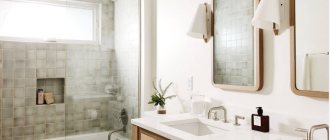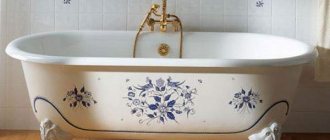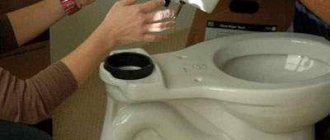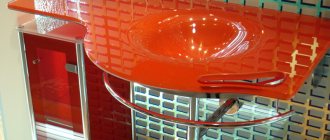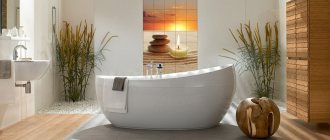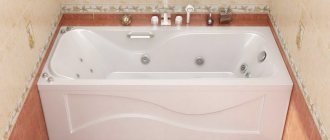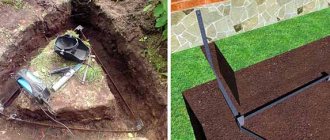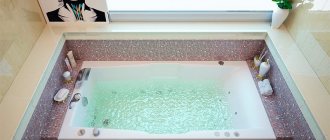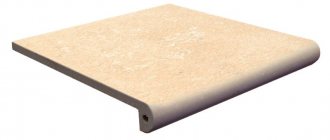Home comfort depends on many factors that are not always visible. There are objects in the house that play an important role, but we attach little importance to them, at least while they are working. This is what happens with the toilet. This is an important home appliance, the failure of which can destabilize the situation in the family. Therefore, it is important to be able to cope with the settings and make initial repairs.
It is worth understanding how you can regulate the water level, what to do if it falls or rises. To do this, we will provide examples with photos, as well as video instructions.
What types of toilets are there?
Basically, toilets are distinguished according to the principle of fastening: floor-mounted, wall-hung and attached.
A wall-hung toilet takes up little space, but is quite difficult to install
Classic flooring options come in a variety of shapes, and there is plenty to choose from in this category. Basically, the tank is mounted directly on the seat, but there are also models with a separate tank located a little higher. The cast design, in which the tank and bowl are one piece, eliminates the need for the owner to periodically repair the tank and change the rubber cuff.
Advantages of floor-mounted plumbing:
- simple and convenient design;
- installation is carried out without complications;
- reasonable prices.
Flaws:
large dimensions. Small selection of compact models.
Wall-hung toilets have come into fashion relatively recently. While widely used in Europe, suspended structures are rare in domestic bathrooms. They are distinguished by the absence of legs and are attached to the wall using anchor bolts. The toilet tank is not visible; it is installed in a false wall.
Design advantages:
- stylish, elegant and compact. An ideal option when there is a shortage of square meters;
- variety of models;
- ease of cleaning.
Disadvantages of the hanging option:
- high price;
- complex installation.
An attached toilet is a hybrid of a floor-mounted and wall-hung one. The bowl is mounted on a leg, like a traditional toilet, and the tank is hidden in the wall, like a floor-standing one. This option has few fans, so the range of attached models is not wide.
The cistern of the attached toilet is hidden in the wall
This is interesting: Corrugation for the toilet - dimensions, installation, how to change, types
SANITA LUXE Art (with microlift)
Photo: https://beru.ru
The Sanita luxe Art compact toilet is made of durable and environmentally friendly sanitary porcelain. Thanks to the unique Sanita Crystal coating, you are guaranteed the hygiene of the product: dirt does not linger on the surface, the toilet is easy and simple to clean. Thanks to the microlift, the lid lowers smoothly and silently onto the seat, making operation as convenient as possible. The product retains its pristine whiteness for many years.
SANITA LUXE Art (with microlift)
Advantages:
- price
- design
- compact
- quality
- anti-burst
- microlift
Flaws:
- doesn't wash off well
Suspended modification with installation
The word “installation” in this case should be understood as the word “hide” or “conceal”. When talking about installing a toilet, we are talking about the structure and fastening elements of the toilet built into the wall. This toilet significantly saves space in the bathroom and looks very stylish and neat. For a small room this is the best option.
Compared to conventional toilets, wall-hung toilets have significantly more advantages:
- Maintaining hygienic cleanliness in the bathroom with such models is much easier. There is no need to constantly clean the toilet mounting points, as well as various cracks between the floor and plumbing.
- If a heated floor or expensive floor covering is installed in the bathroom, then they will not be affected during plumbing repairs.
- Due to the fact that everything unnecessary is hidden in the wall (fasteners, tank), and only the drain button remains visible, it looks minimalist and stylish.
A wall-hung toilet also has its disadvantages:
- High price;
- If repairs are necessary, it will be difficult to get to the tank or pipeline valves hidden in the wall.
Features: pros and cons
Advantages:
- versatility - such a drainage system is suitable for equipping a bathroom in any building: residential, public, municipal, industrial;
- no need to wait until the tank is filled to use the flush again;
- water flows and makes noise only during flushing;
- all three installation options are provided: external, built into the wall or in an installation;
- minimal dimensions in any design - an external flush system without a tank allows you to save space.
There is only one drawback - there is no water supply, like a tank. And when the water is turned off, you can only flush the toilet manually if the water is stored in some other container.
No splashing
When choosing a toilet, the main condition for most buyers is the absence of water splashes.
Modern toilets mostly consist of a funnel-shaped bowl, when used, everything goes directly into the drain channel. This avoids unpleasant odors and reduces water consumption. The main disadvantage of such a bowl, as mentioned earlier, is the presence of splashes. This is something to keep in mind when choosing the best toilet. Modern models are designed with an anti-splash system and completely eliminate this problem for the user.
However, you need to carefully study the model and check whether this option really exists. In such models, the drain hole itself has a special structure. It is narrowed downward and directed to the side. The water is at the very bottom of the drain hole.
Sanita Standard comfort with oblique outlet
Photo: https://beru.ru
The budget toilet from the Russian manufacturer Sanita is designed for installation in sanitary units for domestic or industrial purposes. The product is made of sanitary porcelain, which almost does not absorb water and is easy to clean. A microlift is provided for silent lowering of the lid.
Sanita Standard comfort with oblique outlet
Advantages:
- comfortable model
- anti-burst
- easy to clean
- the bowl washes well
- compact
Flaws:
- fragile lid lifter
- ceramic quality
The drain is also different
If you have not decided to purchase a toilet with anti-splash, then pay attention to another factor that affects the amount of splashes. It's a kind of drain
Advice. If you want to try out fashionable new items, you can take a closer look at toilets with additional functions. This is an automatic drain for the forgetful, and a heated seat system for use in the cold season.
Classic floor-standing toilet
Direct drainage involves a powerful pressure of water in the direction from the tank to the drain hole. The disadvantage of this type is that the entire surface is not washed, which means you need to use a brush. In addition, it is this kind of drainage that leads to the formation of splashes.
With a circular drainage system, water moves in a spiral, which means it effectively cleans all surfaces. The disadvantages of this type are that toilets with a circular flush are much more expensive. In addition, they are combined with a narrow opening that can become clogged.
SANITA LUXE Best Red with horizontal outlet
Photo: https://beru.ru
The compact toilet will perfectly fit into the modern interior of the toilet room and make it comfortable. The SANITA LUXE Best Red product is made of reliable and environmentally friendly porcelain. Increased hygiene is ensured by the special Sanita Crystal surface. The toilet is easy to clean and does not cause any hassle in maintenance. The microlift guarantees smooth and silent closing of the lid. The toilet is reliable and retains its pristine whiteness for many years. If you don’t know which anti-splash toilet is better, then we offer SANITA LUXE Best Red!
SANITA LUXE Best Red with horizontal outlet
Advantages:
- price
- design
- compact
- quality
- washes off well
- anti-burst
- seat with microlift
Disadvantages: not found
Accommodation
There are differences in plumbing models based on the type of installation, divided into three types.
Corner and classic models are available, placed next to the wall opposite the entrance. Both types are installed directly on the floor or on a stand. When secured with anchor bolts during installation, it is easy to dismantle the equipment, replacing old with new without causing damage to the floor covering.
Models with an attached skirt do not affect the functionality of the design. It is an aesthetic element created by designers. When doing wet cleaning, do not touch the plumbing equipment with the rag.
Corner floor
Installation is carried out in a standard way. The corner structure is distinguished by the shape of the barrel, which fits in the center of the junction of two wall panels.
Wall or hanging
During installation, a plate is used that is built into the side panel of the toilet. The work is done by professionals. The equipment is secured to the slab in the wall with anchors. Such models are in demand in Europe, but in our country they are rare.
Advantage:
- Easier to clean the toilet.
- Saving space.
- Stylish design
You need to purchase plumbing fixtures after you have become familiar with all types of drains, installation methods and functional features. Choosing the right toilet from quality material will make it easier to care for. Having set anti-splash as a criterion, they understand that the price for such a product is high. This will be affected by the shape of the bowl and the flushing device.
The shape of the splash-free toilet is the same for all models. It has an internal rim that holds back the flow of water leaving the barrel under pressure. If the seller talks a lot of interesting things about a special device in order to sell an expensive illiquid product, then this is not the main thing. It is advised to find plumbing equipment with a suitable bowl equipped with a protective barrier from the inside. Video: Features of choosing a wall-hung toilet
Only a properly selected toilet can be considered comfortable. The choice of new plumbing is influenced not only by convenience, appearance and price
It is important that the toilet fully copes with its main function - it flushes well and does not splash. How to choose just such a toilet?
SANITA LUXE Max (with microlift) with oblique outlet
Photo: https://beru.ru
A plumbing fixture from a Russian manufacturer is a convenient and practical model for a modern interior. SANITA LUXE Max (with microlift) is made of high-quality ceramics using modern injection molding technology. A unique coating with silver ions ensures a white and smooth surface, preventing the accumulation of bacteria and dirt.
SANITA LUXE Max (with microlift) with oblique outlet
Advantages:
- comfortable
- practical
- high quality ceramics
- 2 flush modes
- anti-burst
Flaws:
- short-lived
Flush
How to choose a toilet that flushes well? This, by the way, is a very important condition. A good toilet should flush efficiently
There are two options for draining water:
- Cascade. This flush occurs from one hole in the toilet bowl. This option is uneconomical in terms of water consumption, since flushing occurs with a strong pressure of a large amount of water. These models are good for their budget price and reliability. A significant disadvantage is the lack of hygiene, since the stream of water cannot cover all areas of the toilet bowl. Also, rust very often appears on such bowls.
- Shower. This is undoubtedly the best option. A more modern toilet flush design allows for greater hygiene. Water washes the bowl from holes around the entire perimeter. At the same time, water consumption is quite economical. It must be said that models with shower flush are more expensive than cascade models. But it’s not worth saving on this.
https://youtube.com/watch?v=MQpz6qNWNTw
Choosing a toilet
Gesso W101 with oblique outlet
Photo: https://beru.ru
The Gesso W101 compact toilet from a Russian manufacturer has an oblique single outlet. There are 2 holes in the base - one on each side. They are necessary for rigid installation of the entire structure to the floor covering. In addition to the bowl and tank, the kit also includes a toilet seat, the necessary fittings and mounting bolts. This toilet model is characterized by a highly durable body and ease of installation.
Gesso W101 with oblique outlet
Advantages:
- price
- design
- compact
- washes off well
- quality
- anti-burst
Flaws:
- single flush button
- bad instructions
Drain
If the user is going to install plumbing fixtures on his own, and is doing this for the first time, then it is still worth consulting with a qualified specialist about the nuances that you need to pay attention to when purchasing. After all, the design, location and slope of the drainage system is different everywhere, and in order not to have to worry about installing a piece of plumbing, you need to take care of this in advance by choosing a suitable model
The outlet necks for draining the tank are:
- Vertical. This option is perfect for small toilet rooms, because this design will allow you to attach the toilet as close to the wall as possible.
- Horizontal. This design is suitable for houses with horizontal sewer outlets.
- Angular. In such instances, water is drained at an angle.
SANITA LUXE Infinity
Photo: https://beru.ru
Sanita Luxe is a stylish and functional product design, which is developed based on a detailed analysis of consumer preferences. All products are manufactured on the most modern equipment using innovative technologies. Like, for example, a unique recipe for preparing glaze for sanitary products, which ensures ideal whiteness and smoothness of the surface. Or an antibacterial coating with components based on silver ions, which prevents the growth of germs and bacteria. And for the first time in Russia, nanotechnology is used in the production of sanitary ware. The unique Sanita Cristal coating keeps the toilet bowl clean and white.
SANITA LUXE Infinity
Advantages:
- design
- nanotechnology
- antibacterial coating
- microlift
- anti-burst
Disadvantages: not found
What determines the presence of splashes? Choosing the shape of the bowl
It turns out that the presence or absence of splashes depends on the shape of the bowl. There are three types of toilet bowls:
- Disc-shaped. A traditional bowl shape that differs significantly from other types. Along the path of water from the tank there is a shelf, or a recess in the form of a plate. Human waste entering the toilet lingers on this ledge before entering the drain hole. A powerful drain forms a funnel, which causes splashes.
- Funnel-shaped. A design feature of the funnel-shaped bowl is the location of the drain hole. It is located in the very middle of the recess. All waste goes into the hole immediately, so there is no splashing and no need to use a brush.
- Kozyrkovaya. In this type of toilet, the drain is close to the front side of the product. Instead of the indentation present in the first point, there is a protrusion here. Most of the waste goes straight to the drain. The rest is washed off with a small pressure of water with a minimum amount of splashes.
Increase in water volume
It should be noted that savings most often determine efficiency. And if the water level in the tank has dropped significantly, by saving water, you can ensure that the sewage from the thicket will not be washed off well. In such cases, you have to flush the water several times, which, undoubtedly, has nothing to do with savings. Therefore, a golden mean is needed.
In this case, you need to act in the same way as in the previous one, only this time you need to tighten the plastic screw or bend the brass lever to increase the water level.
Toilet flushing systems
In modern toilet models, sewage is flushed in two ways:
- Direct flush;
- Reverse circular flush.
Direct flush
The direct flush system is characterized by the fact that water moves almost in a straight path from the drain hole of the tank along the wall of the bowl to the drain. Due to the straight trajectory of the water flow, direct drainage is also called cascade or horizontal.
In principle, this flushing system was implemented in almost all models of toilets manufactured during the Soviet era.
+ The advantage of direct drainage is that in one go, releasing a powerful stream of water, you can wash away all the impurities located in the center of the bowl.
— The disadvantage of direct drainage is that during descent the water flow does not cover or only slightly washes the inner surfaces of the bowl, as a result it is necessary to use a brush.
Circular flush
A reverse circular flush, or as it is also called a ring or shower system, is fundamentally different from the flush described above. In a shower system, water does not flow in a straight path, but when the tank is lowered, the pressure moves along a kind of annular groove and flows evenly over the entire area of the bowl.
+ The advantage of the reverse circular system is that there is practically no noise and, during flushing, the entire surface of the bowl is uniformly washed.
— Disadvantages of a circular system - the plumbing in which this system is implemented is much more expensive than toilets with direct flush.
There is also a high risk that after a few years, the drain holes located in the gutter under the rim may become clogged due to salt deposits.
When wondering how to choose a toilet that flushes well, as a rule, you have to choose between “two evils.” In the first case, plumbing will cost less, but sometimes it will be necessary to resort to a brush. In the second case, the plumbing will cost more, but the toilet will always be clean and tidy.
Drain mechanism design
Externally, it looks like a piece of pipe with a diameter of at least 20 mm. But inside this pipe all the elements that provide portioned drainage are placed. Structurally, any drukshpuler includes:
- drain pipe through which water flows into the toilet;
- power button or lever;
- internal cartridge divided into upper and lower compartments;
- a bypass membrane with a hole installed between the compartments;
- two valves - main and auxiliary;
- return spring.
The upper part of the dryer is connected to the water main, and the lower part is connected to the toilet drain.
Know-how in the world of plumbing or a little about smart toilets
Progress does not stand still and by leaps and bounds has not bypassed even such a hygiene item as a toilet. The concept of “smart toilet” is understood as the integration and introduction into the overall toilet system of various technical solutions, which mainly contribute to the comfortable disposal of natural needs or maintaining the proper sanitary level.
Bidet toilets are widely popular. At first, representatives of Islamic culture greatly appreciated the bidet. Due to religious canons, they do not use paper, but wash themselves. However, many enterprising Europeans quickly adopted this method of going to the toilet, due to the fact that it is more hygienic than using paper. In our country, bidets began to be used relatively recently, but the demand for this type of toilet is constantly growing.
Another popular upgrade is an auto-flush. A very useful invention, especially for forgetful “citizens” or simply for those who are used to keeping things clean.
A heated seat is a useful innovation for the female half of humanity, especially in the winter. Naturally, heating can be carried out either in automatic mode - continuously, or triggered at the moment you start using the toilet.
Floor model
This type of toilet is the most common because it is easy to install. You literally need to screw a couple of screws to the floor and then fix the toilet with a cement solution. Any man can handle this. Also, such structures are usually small in size, and besides, their cost is an order of magnitude lower than suspended structures.
The disadvantages of such models are:
- difficulties in cleaning the bathroom;
- the difficulty of choosing a model from a wide variety;
- rather unaesthetic appearance.
Now on sale you can find models of toilets that combine the qualities of a floor-mounted and wall-hung toilet. The barrel of such plumbing is hidden in the wall, and the bowl itself is attached to the floor. This type of toilet is called a side-mounted toilet.
Advantages of attached modifications:
- All fasteners, valves and a drain tank are hidden in a niche and thus do not “eat up” the space in the room. It also looks very laconic.
- The bowl has a lid and convenient fasteners.
Disadvantages of attached modifications:
- Labor-intensive maintenance and repairs;
- Some inconveniences in maintaining the hygienic cleanliness of the bathroom.
Design features of a toilet without a tank
Floor-standing toilet without cistern
Plumbing fixtures in which the toilet is installed separately and the flush tank is hidden in a niche or behind a false panel cannot be considered tankless. They also do not include so-called “construction” toilets, which are not connected to the water supply at all. In them, flushing is carried out using a bucket or hose.
Real toilets without a flush tank are completely connected to the water main, but in principle there is no storage tank in the design. In them, flushing is carried out by a small device called a “drukspühler”. It is connected to the water supply and upon startup ensures the dispensing of a given volume of liquid.
Which toilet flushes better?
The quality of toilet flushing is affected by:
- bowl shape;
- flushing system devices;
- type of exhaust system;
- location of the cistern.
Toilet bowls
The shape of the toilet bowl not only determines its appearance, but also affects the quality of the flush. Toilet bowls are:
Funnel-shaped toilet bowls. The drain hole in toilets with such a bowl is located almost in the center and, therefore, the flush will be good. Such toilets are considered the most hygienic, since sewage does not linger in the bowl. It does not require daily cleaning and is considered economical to use. The only, but very noticeable, disadvantage of such bowls is multiple splashes when flushed.
Visor bowls. The back wall of the bowl is convex and inclined. In such a toilet, sewage does not accumulate, but immediately goes into the drain hole. This makes the use of plumbing fixtures hygienic and virtually eliminates the problem of unpleasant odors in the bathroom. The absence of stagnant water avoids the formation of rust and stains. The design of a toilet with this bowl shape is recognized by experts as the most successful and is manufactured by all well-known global manufacturers.
Toilets with a plate bowl were widespread in the second half of the last century. The drain hole is shifted forward, and the shape of the bowl suggests the presence of a shelf. The only advantage we can highlight is the complete absence of splashes. Below are just the downsides:
- the need for regular frequent cleaning of the surface;
- unpleasant odors in the toilet;
- stagnation of water in the bowl and the formation of rust.
Currently, toilets with a bowl bowl are not relevant and are considered relics of the past.
Flush system
The supply of water and its further distribution in the bowl play a fundamental role for a good flush. The flushing system is of two types:
- cascade (direct flush);
- shower (circular flush).
Cascade flush is considered a classic in toilets. Water is supplied from the tank in one continuous stream along a straight path. The advantages include a powerful flow of water that can wash away all impurities.
Disadvantages of direct flush:
- uneven washing of the bowl;
- the need for additional cleaning of the front wall of the toilet;
- water consumption is not economical;
- rust formation near the water supply hole.
Shower flush is more modern. The principle of its operation is completely opposite to direct flushing. In the gutter under the rim of the toilet there are holes into which water is supplied from the tank. In the bowl, the water flows in a circle, forming a ring gutter.
- complete washing of the bowl;
- easier care of the bowl;
- silent flush;
- saving water used.
- clogged drain holes;
- high price.
Exhaust system
The toilet exhaust system determines how it is installed to the sewer system.
- Vertical. A vertical outlet is appropriate when the sewer pipe is moved 50-60 cm away from the wall. This outlet is also widely used in private construction.
- Horizontal. A horizontal exhaust system is used when the sewer inlet is located in a riser or is significantly elevated above the floor.
- Oblique. The oblique outlet is located at an angle of 45º. The toilet is connected to a sewer pipe located at floor level.
Each exhaust system has no advantages or disadvantages and does not affect flushing. At the same time, this is a very important parameter when choosing a toilet.
Location of the cistern
The plumbing market offers both “compact” systems, when the toilet and cistern are one whole, and separate sets.
Wall-hung toilets with a tank mounted on the wall are becoming increasingly popular. The higher location of the tank creates powerful water pressure, thereby ensuring reliable and high-quality flushing. Choosing such a toilet model will be an excellent solution to the problem of lack of space in the bathroom.
The nuances of installing a floor-mounted tankless toilet
A floor-standing toilet equipped with a tankless flush system is installed and connected to the sewer system in the same way as any device of this kind. But connecting it to the water supply has its own characteristics. If absolute accuracy is observed in this matter, then the sequence of operations when installing the dryer will be as follows:
- It makes the most sense to carry out the installation in the same place; moving communications is too expensive. But if the plumbing fixture is installed offset or simply in a new location, then, first of all, cold water should be supplied to the installation site. Moreover, the connection point must be placed on the wall so that it is in the middle of the device at a distance of 90 cm from the floor.
- As a rule, the liner is placed in a groove made on the wall, leaving only a connecting hole. Subsequently, the site of the destruction is sealed. It is very important to select the correct pipe diameter when supplying water to the place where the drukshpuler is attached. Next, a plug is placed on the supplied pipe, since the remaining operations will be performed upon completion of the finishing work.
- Once the finishing of the bathroom is completed, you can begin installing the plumbing fixture, and you can choose any model. This can be a floor-standing toilet without a tank, or a product designed for mounting on a wall or installation system. The installation process will correspond to the type of model torn out.
- Next, the drukspühler itself is mounted on the wall cladding. The equipment looks compact, so it does not take up much space, being located directly next to the toilet. Now you need to connect the drukspühler to the riser outlet coming out of the wall, having first removed the plug from it. The union nut, with which the ends are connected, is first screwed on by hand, and then finally tightened with a wrench. Using the same union nuts, the ends of the pipe are connected to the drainer and the plumbing fixture. When connecting to the latter, a silicone gasket must be used.
Type of drukspühler
That's it, the installation process can be considered complete. Now you can open the water and make sure that the device is working properly. As you can see, this matter is not so complicated. According to professionals, such installation is much easier than installing a toilet with a flush tank. This was largely facilitated by the pedantic Germans who invented this device. They thought through everything down to the smallest detail to make installation work as simple as possible.
A toilet with a hidden cistern as an alternative to a tankless toilet
Toilet with drainer
Tankless toilet
Toilet with drainer
Wall-hung toilet with hidden cistern
Toilet without cistern in the toilet View of the drukspühler
Floor standing tankless toilet
Shape and material
For many buyers, the main criterion when buying a toilet is the quality of the material from which it is made. This is what guarantees the quality of the product and durability of use.
Models of this plumbing fixtures can be divided according to material into:
- Earthenware. These are usually small and fairly budget options. That is why they are very popular among buyers. The entire toilet bowl is covered with a thick layer of earthenware, which is specially fired, thereby increasing the strength and reducing the porosity of the material.
- Porcelain. These are very easy to install and durable models. With careful use, they will last for many years without causing any problems. The difference between these toilets is their modern exterior. Such models are the most hygienic when compared to earthenware toilets, as they are less porous and very easy to clean. The only drawback is their considerable cost.
- Steel. These are very durable, wear-resistant structures that will last for decades. They are very easy to keep clean. Many users of such models emphasize that this is the most comfortable option of all others. The good thing about them is that the design is very compact and fits perfectly into any toilet room.
- Toilets made of natural stone. This is the most expensive option of all types. Its surface is perfectly polished, which makes it very easy to care for the product. The downside is that they are usually bulky and subject to mechanical stress. This model is not practical.
- Toilet bowls made of artificial stone. These models are made from crushed natural stone and a composition of components that ensure the strength of the product. This is a very stylish and modern option. The toilet cover is quite hygienic and resistant to mechanical stress. Such an example will cost an order of magnitude cheaper than a model made of natural stone, and its design will also be more compact.
- Acrylic or plastic. These are very strong and durable models. The surface of the material is very smooth, which makes it easy to care for the product. This option is considered very hygienic. An important disadvantage of such products is their susceptibility to high temperatures and mechanical damage.
We figured out the material of the product. As for the shape and other parameters of the models, there are also several options. The bowl can be of several types:
- Disc-shaped. This bowl is a horizontal platform. This design is convenient because there is no splashing water in this toilet. However, this is the most unhygienic design of all, because everything that falls into the bowl remains on this platform. And besides this, there is always stagnant water in the toilet, which over time leads to salt deposits, as well as the appearance of rust. When choosing such plumbing fixtures, you need to think carefully about what is more important - comfort or hygiene.
- Funnel-shaped. Such a bowl contains a funnel right in the center of the bowl and everything that falls into it goes straight into this funnel filled with water. This is the most hygienic option and is also easy to install. But such models also have disadvantages. The most important thing is the presence of constant splashes of water.
- Kozyrkovaya. This is something common between disc-shaped and funnel-shaped modifications. This is the most convenient version of the bowl design, thanks to which there is no splashing and the toilet itself is very convenient and comfortable to use.
Choosing a cistern
When installing a drain tank, a shut-off valve must be installed to shut off the water, since the shut-off device should be inspected annually
The valve is the most important and complex part of the toilet kit. Its task is to ensure complete and quick flushing of the contents of the toilet bowl, and then automatically fill with water to a certain volume
This device is often sold complete with a toilet.
Quiet operation is one of the main signs of the quality of the drain tank
Pay attention to this - a strong noise when filling the drain tank with water indicates incorrect installation or the presence of a manufacturing defect in the product. To insure against this, it is better to purchase toilets in highly specialized stores, where you can get a guarantee on them
When choosing a flush container, look at the type of tank and its location relative to the toilet. There are samples with both a separate location and a joint one. A separate arrangement usually involves a suspended tank, which is attached to a specially designed frame. The container can be placed at any height according to your wishes. In joint models, it is mounted to the toilet (from above) and can be attached or solid.
